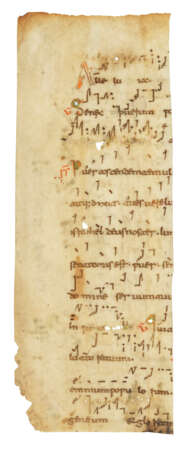ID 1053136
Лот 22 | Beneventan neumes
Оценочная стоимость
£ 5 000 – 8 000
Gradual, with tropes and prosulas, in Latin, illuminated manuscript on vellum [Southern Italy, 11th century]
An elegant and clear specimen of Beneventan minuscule and neumes, clearly illustrating the musical differences between tropes and prosulas and the varying occurences of these texts in the Beneventan zone.
A partial leaf, c.190 x 70mm, blind-ruled for parts of 12 lines written in brown ink in Beneventan minuscule, Beneventan diastematic (heightened) staffless neumes over each line, initials coloured with red, orange and green, liturgical directions for versicles in orange or red (recovered from a binding, one side more stained and darkened than the other). Bound in grey buckram at the Quaritch bindery.
Provenance:
(1) Bernard Quaritch Ltd. Bookhands of the Middle Ages IV: Beneventan Script, cat. 1128 (1990), no 4, acquired May 1988.
(2) Schøyen Collection, MS 66.
Text:
The text of the present fragment is the for the Purification of the Virgin on 2 February. It contains, for the introit, the trope verse 'Offert dies' (from the trope 'Adest alma virgo', published in Analecta hymnica, vol.49, p.32) followed by the introit itself ('Suscepimus'); gradual ('Suscepimus'); Alleluia ('Senex puerum'); prosula ('Puer ascendentem'); and tract ('Nunc dimittis'). Tropes are verse texts added to sung parts of the mass sometimes as extensions of verses or phrases (such as in the case of this fragment), at other times as prefatory material (for example, the famous Quem quaeritis Easter play). Originating during the late Carolingian era in monasteries and cathedrals, they reached their highpoint of diffusion and elaboration in the 11th and 12th centuries. Prosulas, on the other hand, are short textual additions set to the music of a long melisma (an extended phrase on a syllable), especially in an Alleluia where extended musical phrases on individual syllables are naturally expected.
The texts of the required elements are those usual in Beneventan manuscripts, however, while the trope is also found, for example, in Benevento, Biblioteca Capitolare 34, f.47, this same codex does not have the prosula (which appears instead in Benevento, Biblioteca Capitolare 35, f.16v, and Zagreb, Metropolitanska Knjiznica MR 166, p.345). In the Beneventan region tropes are found in the Introit chant throughout the major feasts of the liturgical year, and in a single case for the Offertory too. For further reading, see A.E. Planchart, Beneventanum troporum corpus I: Tropes of the Proper of the Mass from Southern Italy, A. D. 1000-1250, 1994.
Script and music:
The presence of the quilisma (a neume found on the verso, line 10 'populorum') and the lack of clefs or staves are indicative of a date before the 12th century. The script is 11th century: letters are well-formed and exhibit the approach- and finishing-strokes which later attain thick lozenge shape in the time of Desiderius; the final 'r' is long; illuminated initial letters at the beginning of texts are simply made; and some titles are written in orange instead of red.
| Место происхождения: | Италия |
|---|---|
| Категория аукционного дома: | Манускрипты Средневековья и Ренессанса |
| Место происхождения: | Италия |
|---|---|
| Категория аукционного дома: | Манускрипты Средневековья и Ренессанса |
| Адрес торгов |
CHRISTIE'S 8 King Street, St. James's SW1Y 6QT London Великобритания | ||||||
|---|---|---|---|---|---|---|---|
| Предосмотр |
| ||||||
| Телефон | +44 (0)20 7839 9060 | ||||||
| Комиссия | see on Website | ||||||
| Условия использования | Условия использования |




